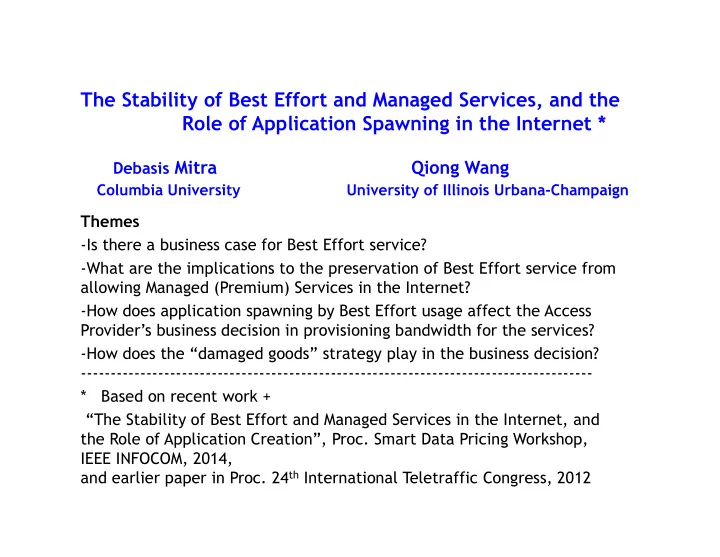

The Stability of Best Effort and Managed Services, and the Role of Application Spawning in the Internet * Debasis Mitra Qiong Wang Columbia University University of Illinois Urbana-Champaign Themes -Is there a business case for Best Effort service? -What are the implications to the preservation of Best Effort service from allowing Managed (Premium) Services in the Internet? -How does application spawning by Best Effort usage affect the Access Provider’s business decision in provisioning bandwidth for the services? -How does the “damaged goods” strategy play in the business decision? -------------------------------------------------------------------------------------- * Based on recent work + “The Stability of Best Effort and Managed Services in the Internet, and the Role of Application Creation”, Proc. Smart Data Pricing Workshop, IEEE INFOCOM, 2014, and earlier paper in Proc. 24 th International Teletraffic Congress, 2012
Mapping to Two-Sided Market Model N 1 BEST EFFORT USERS A APPLICATIONS ACCESS PROVIDER A N 2 MANAGED SERVICE USERS Key Model Features: • ������������������������������������������������������������������� • Two classes of users: Best Effort & Managed Services BE is “free” but incurs delay and negative utility; MS users pay fee to avoid delay Utility- ��������������������������������������������������������������� • Negative externality – delay to BE users increases with #(BE users) • Profit maximizing Access Provider decides on how much BandWidth (BW) to provision for BE and MS at fixed rental cost per unit BW, and also decides MS transaction fee • Access Provider levies transaction fee to MS users, plus fixed fee to all subscribers • Users’ utility is proportional to number of Applications, A • Spawning of new applications is proportional to BE usage
� Model Parameters MS BE Service � � = � � � � higher WtP to avoid delay 3
Analysis 4
Results hold A, #(Applications), fixed Solve for Users and Access Providers behavior and decisions, compute profit Compute A’s drift from dynamics of “application spawning” Re-solve Obtain characteristics of A’s “attractor”, i.e., steady state, and corresponding BE and MS bandwidth deployed at attractor as operating point Main result For fixed A, the result of the self-optimizations by Users and Access Provider gives function K(A) such that K(A) > 0 only BE service is offered by Access Provider K(A) < 0 only MS service is offered by Access Provider K(A) Attractor of A A #(applications) � � drift of A MS only BE Service only MS only 5
Recommend
More recommend